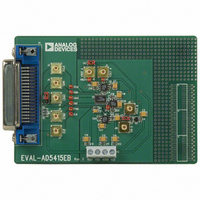EVAL-AD5415EBZ Analog Devices Inc, EVAL-AD5415EBZ Datasheet - Page 17

EVAL-AD5415EBZ
Manufacturer Part Number
EVAL-AD5415EBZ
Description
BOARD EVALUATION FOR AD5415
Manufacturer
Analog Devices Inc
Specifications of EVAL-AD5415EBZ
Number Of Dac's
2
Number Of Bits
12
Outputs And Type
2, Differential
Sampling Rate (per Second)
2.47M
Data Interface
Serial
Settling Time
120ns
Dac Type
Current
Voltage Supply Source
Single
Operating Temperature
-40°C ~ 125°C
Utilized Ic / Part
AD5415
Lead Free Status / RoHS Status
Lead free / RoHS Compliant
Positive Output Voltage
The output voltage polarity is opposite to the V
dc reference voltages. To achieve a positive voltage output, an
applied negative reference to the input of the DAC is preferred
over the output inversion through an inverting amplifier
because of the resistors’ tolerance errors. To generate a negative
reference, the reference can be level-shifted by an op amp such
that the V
ground and −2.5 V, respectively, as shown in Figure 37.
ADDING GAIN
In applications where the output voltage must be greater than V
gain can be added with an additional external amplifier, or it can
be achieved in a single stage. Consider the effect of temperature
coefficients of the thin film resistors of the DAC. Simply placing
a resistor in series with the R
temperature coefficients, resulting in larger gain temperature
coefficient errors. Instead, the circuit in Figure 38 shows the
recommended method for increasing the gain of the circuit.
R1, R2, and R3 should have similar temperature coefficients,
but they need not match the temperature coefficients of the
DAC. This approach is recommended in circuits where gains
of greater than 1 are required.
NOTES
1. ADDITIONAL PINS OMITTED FOR CLARITY.
2. C1 PHASE COMPENSATION (1pF TO 2pF) MAY BE REQUIRED
NOTES
1. ADDITIONAL PINS OMITTED FOR CLARITY.
2. C1 PHASE COMPENSATION (1pF TO 2pF) MAY BE REQUIRED
V
IN
IF A1 IS A HIGH SPEED AMPLIFIER.
IF A1 IS A HIGH SPEED AMPLIFIER.
+5V
–5V
Figure 37. Positive Voltage Output with Minimum of Components
R1
V
OUT
ADR03
Figure 38. Increasing the Gain of the Current Output DAC
GND
OUT
–2.5V
V
V
IN
and GND pins of the reference become the virtual
REF
A
V
REF
V
V
12-BIT DAC
GND
DD
DD
A
V
DD
12-BIT DAC
V
GND
DD
= 5V
R
FB
FB
I
I
A
OUT
OUT
R
resistor causes mismatches in the
FB
1A
2A
I
I
A
OUT
OUT
1A
2A
C1
C1
R3
R2
REF
V
polarity for
OUT
GAIN =
R1 =
= 0 TO +2.5V
V
R2 + R3
OUT
R2R3
R2 + R3
R2
Rev. B | Page 17 of 32
IN
,
DIVIDER OR PROGRAMMABLE GAIN ELEMENT
Current-steering DACs are very flexible and lend themselves to
many applications. If this type of DAC is connected as the
feedback element of an op amp and R
resistor, as shown in Figure 39, the output voltage is inversely
proportional to the digital input fraction, D.
For D equal to 1 − 2
As D is reduced, the output voltage increases. For small
values of the digital fraction, D, it is important to ensure that
the amplifier does not saturate and that the required accuracy is
met. For example, an 8-bit DAC driven with the binary code 0x10
(0001 0000)—that is, 16 decimal—in the circuit of Figure 39
should cause the output voltage to be 16 times V
the DAC has a linearity specification of ±0.5 LSB, D can have a
weight in the range of 15.5/256 to 16.5/256, so that the possible
output voltage is in the range of 15.5 V
3%, even though the DAC itself has a maximum error of 0.2%.
DAC leakage current is also a potential source of errors in
divider circuits. The leakage current must be counterbalanced
by an opposite current supplied from the op amp through the
DAC. Because only a fraction, D, of the current into the V
terminal is routed to the I
changes as follows:
Output Error Voltage Due to DAC Leakage = ( Leakage × R )/ D
where R is the DAC resistance at the V
For a DAC leakage current of 10 nA, R = 10 kΩ, and a gain (that
is, 1/D) of 16, the error voltage is 1.6 mV.
V
OUT
= − V
Figure 39. Current-Steering DAC Used as a Divider or
V
IN
NOTES
1. ADDITIONAL PINS OMITTED FOR CLARITY.
IN
/ D = − V
I
I
OUT
OUT
Programmable Gain Element
−n
, the output voltage is
2A
1A
R
FB
IN
A
OUT
/(1 −2
1A terminal, the output voltage
GND
V
V
DD
DD
−n
)
V
REF
FB
IN
A
REF
is used as the input
to 16.5 V
A terminal.
V
IN
IN
OUT
. However, if
—an error of
AD5415
REF
A




















